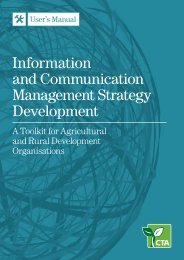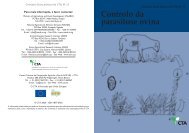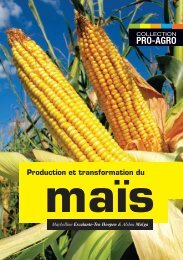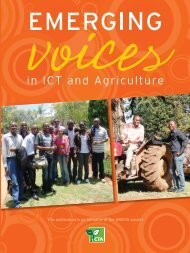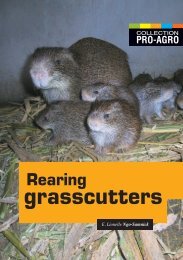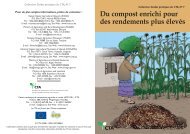Policy framework for Pastoralism in Africa
Policy framework for Pastoralism in Africa
Policy framework for Pastoralism in Africa
- No tags were found...
You also want an ePaper? Increase the reach of your titles
YUMPU automatically turns print PDFs into web optimized ePapers that Google loves.
with resident farmers. These problems are exacerbated by ready access to modern small arms. Tosome extent, conflict and poverty are <strong>in</strong>ter-related and mutually re<strong>in</strong><strong>for</strong>c<strong>in</strong>g. For example, youngmen without livestock but want<strong>in</strong>g to marry, may be more likely to raid livestock from others orresort to banditry.There<strong>for</strong>e, peace and security rema<strong>in</strong>s fundamental to protect<strong>in</strong>g and develop<strong>in</strong>g pastoralism <strong>in</strong><strong>Africa</strong>. Part of the policy challenge here is the position of pastoralists <strong>in</strong> remote areas, often on theedges of states, and their mobility. There<strong>for</strong>e, pastoralists can be regarded as contribut<strong>in</strong>g to conflictand <strong>in</strong>security, <strong>for</strong> example, by support<strong>in</strong>g armed <strong>in</strong>surgency groups or perpetrators of organisedcrimes. Similarly, although pastoral movements have a strong economic and ecological rationale,these benefits are easily outweighed by national security concerns. As proposed <strong>in</strong> the policy <strong>framework</strong>,dialogue with pastoral communities is central to the process of improved security, as is<strong>in</strong>tegrat<strong>in</strong>g pastoral areas <strong>in</strong>to ma<strong>in</strong>stream development policies and plans.3.3.2 Demographic trendsIn general, population growth <strong>in</strong> pastoralist areas is estimated at 2.5 to 3.5 percent per year, whichequates to a doubl<strong>in</strong>g of population every 25 to 35 years. Historical analyses <strong>in</strong>dicate that globally,pastoral areas are unable to absorb or susta<strong>in</strong> a grow<strong>in</strong>g human population and that as populationgrows, at some po<strong>in</strong>t ‘excess’ people move away from pastoralism as a way of life and a means oflivelihood. These push factors <strong>in</strong> pastoral areas can comb<strong>in</strong>e with pull factors from urban centres,which may offer alternative and less risky or easier lifestyles and job opportunities. Town and citiesalso tend to offer better education and health services. As people leave pastoralism, other peoplerema<strong>in</strong> very much <strong>in</strong> the system and cont<strong>in</strong>ue to rear livestock as the ma<strong>in</strong> means of livelihood. Inpart, pastoralism survives because there are so few alternative ways of liv<strong>in</strong>g <strong>in</strong> arid and semi-aridareas. However, <strong>in</strong> areas with relatively higher ra<strong>in</strong>fall and the option of crop production, pastoralistsare under <strong>in</strong>creas<strong>in</strong>g pressure from farmers and <strong>in</strong> the absence of land tenure, lose their landand way of life.In theory, job creation <strong>in</strong> pastoral areas might be l<strong>in</strong>ked to commercial exploitation of naturalresources such as oil, m<strong>in</strong>erals or natural gas. Very often however, pastoral areas rema<strong>in</strong> undeveloped(e.g. due to <strong>in</strong>security) or when <strong>in</strong>vestment does occur, few jobs fall to pastoralists (e.g. becauseof low levels of education) and revenues are rarely re-<strong>in</strong>vested locally. These trends cause furtherresentment and at times, trigger conflicts.As human population grows <strong>in</strong> pastoral areas, the impacts of natural or other disasters are amplifiedas more people are affected. Various and potentially damag<strong>in</strong>g livelihood strategies are usedby those who fall out of pastoralism. These strategies <strong>in</strong>clude: non-susta<strong>in</strong>able use of naturalresources, such as cutt<strong>in</strong>g trees <strong>for</strong> charcoal production and sale; send<strong>in</strong>g daughters to work ashouse servants <strong>in</strong> towns, thereby expos<strong>in</strong>g them to risk of abuse; engag<strong>in</strong>g <strong>in</strong> illegal contrabandtrade; and crim<strong>in</strong>al activity such as ‘organized livestock raid<strong>in</strong>g’ or banditry.Demographic trends are very much l<strong>in</strong>ked with other trends <strong>in</strong> pastoral areas, especially loss ofrangeland and commercialization of livestock production and market<strong>in</strong>g. For example, the ‘highexport’ and relatively commercialized pastoral areas of Sudan and Somalia are characterized by agradual transfer of livestock from smaller/poorer herders to larger/richer herders, with the <strong>for</strong>merfall<strong>in</strong>g out of pastoralism and the latter expand<strong>in</strong>g their herds and sell<strong>in</strong>g more animals <strong>in</strong>to theSecur<strong>in</strong>g, Protect<strong>in</strong>g and Improv<strong>in</strong>g the Lives, Livelihoods and Rights of Pastoralist Communities25




